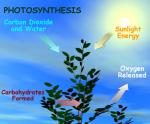|
This section contains 353 words (approx. 2 pages at 300 words per page) |
Photosynthesis
Light consists of tiny packets of energy called photons. When light shines on you, your body has a stream of protons hitting the surface. Molecules that absorb light are called pigments. The major light absorbing pigment in plants is chlorophyll. In green plants, chlorophyll is found in chloroplasts within plant cells. When atoms in a pigment absorb light, electrons are boosted to higher energy levels. The energy in the photons is transferred to the electrons, causing a move. A certain kind of pigment can absorb only photons with the appropriate amount of energy. Chemical reactions that involve the transfer of electrons from one atom or molecule to another are called Oxidation-Reduction reactions. Carbohydrates produced by plants during photosynthesis contain many energy rich electrons, and are highly reduced. Light hits the surface of a leaf. The light energy causes chemical reactions to occur inside chloroplasts in the leaf's cell. Photosynthesis in plants occurs within the chloroplasts. The pigment chlorophyll that absorbs photons is found in structures called thylakoids.
Inside the chloroplast, photosynthesis begins when light strikes a chlorophyll molecule in the membranes a thylakoids. The light excites an electron that is joined to a proton donated by water. The energy carried by the electron powers a proton pump that transports a proton across the membrane into the thylakoids. When light strikes a second kind of chlorophyll, the excited electron does not use its energy to drive a proton pump. Instead, it is combined with a proton and joined to NADP, forming NADPH. Protons inside the thylakoids are driven by diffusion through a protein channel. The force of their exit adds phosphate to ADT, forming ADP.
|
This section contains 353 words (approx. 2 pages at 300 words per page) |


